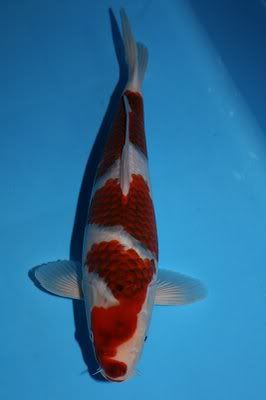Pic.1 Goromo Ki Fish Allandalekoi Photo Collection
Goromo are Koi Fish that have black shading over their patterns. Goromo means “robed” or “veiled”, and refers to the most common appearance of the “vignette” of these koi. The outer third of the area covering each scale tends to carry the darker color, beginning from the indistinct melding of the colors toward the center of each scale and finishing at the scale edge as a neat dark blue or black line.
Goromo koi and asagi koi are the perfect koi fish for your ornamental pond With a gentle disposition, Goromo and Asagi koi fish are hardy and long-lived. It is as though a wash of dark paint has been gently drawn across part of each scale area within the hi element, but has not completely covered them. Modern Goshiki often have the scale reticulation only over the white scale areas, and this is much cleaner and sharper looking than conventional Goromo robbing.
Pic.2 Budo Goromo, Yamakosi Photo Collection
Goromo Koi fish developed by interbreeding of Kohaku and Asagi koi Fish.Goromo are a group of koi fish ideally patterned similarly to Kohaku, Sanke and Showa, with the additional common feature of a scale reticulation over the red patterns (hi) or, in the case of Goshiki, over red and white, or over white only. The reticulation pattern may be blue or black in color. They are a multi patterned, non-metallic koi fish. All Koromo have a common Asagi bloodline that is crossed with Kohaku, Sanke, and Showa to produce the specific members of the group.
Sumi Goromo are Goromo where the reticulated effect, or robing, over the hi elements is black, rather than blue. Budo Goromo develops with dark purple markings covering small groups of scales, creating shapes like bunches of grapes. These often look like a “black, rather then red” Kohaku. They can be very striking.
Young Ai-Goromo may be indistinguishable from Kohaku Koi Fish, as the blue scale reticulation often does not develop until the koi is several years old.
Ai-Goromo are very elegant, having clear white skin and hi markings delicately etched with a blue vignette.A little blue tinted sashi is acceptable, where the scales insert into the skin at the leading edge of each hiban (red area) but the kiwa (red edge) should always be well defined. Thus, the blue color should not “run” from the hi into the white skin following the trailing edge of a pattern element.When this occurs, as it sometimes does for an older Goromo, this koi is said to be going “Goshiki”.
Goromo have been a bit undervalued in the past, but good examples can reveal to you the possibilities they can achieve.A very nice koi fish to have in any pond. Goromo matures with age, dark robbing will often grow even darker with age to the point where the scalation effect is totally lost.
The best Ai-Goromo hi will usually be apricot colored in the youngster and the Goromo will be indicated by very small, very faint bluish markings, usually only seen in the hi markings along the flanks. The hi can be very unstable and susceptible to shrinking and fading, which necessitates close inspection of the kiwa of the hi for stability. In Budo Goromo, the sumi must not be too blotchy or too large. For all Goromo, the white ground must be of the highest quality to offset the ai or budo.
Source :
1.Makc Library






0 comments:
Post a Comment